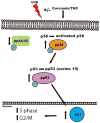Curcuminoids activate p38 MAP kinases and promote UVB-dependent signalling in keratinocytes
- PMID: 20456495
- PMCID: PMC3099406
- DOI: 10.1111/j.1600-0625.2010.01081.x
Curcuminoids activate p38 MAP kinases and promote UVB-dependent signalling in keratinocytes
Abstract
Curcuminoids exhibit anti-proliferative properties in many cell lines by modulating signalling pathways to inhibit cell growth. However, the specific effects of curcuminoids on human keratinocytes are not well defined, and this situation impairs mechanistic thinking regarding potential therapeutic uses. We hypothesized that curcuminoids would modulate key growth regulatory pathways in keratinocytes to inhibit cell proliferation. To test this hypothesis, the effects of curcumin and tetrahydrocurcumin (THC) on mitogen-activated protein (MAP) kinase signalling in keratinoctyes were determined. Primary human keratinocytes treated with curcumin or THC demonstrated decreased activation of p44/42 MAP kinases but increased levels of activated p38 MAP kinases. These data suggest that curcuminoids specifically activate stress-induced MAP kinases while inhibiting mitogen-induced MAP kinases. Curcuminoids also promote the phosphorylation of p53 on serine 15 in a dose-dependent and p38-dependent manner, suggesting that these compounds may activate p53. The effects of curcuminoids on keratinocytes mirrored some aspects of UVB and could be inhibited by N-acetylcysteine, suggesting that these compounds activate p38 through a mechanism that involves glutathione depletion. Both curcuminoids induced G2/M block and inhibited keratinocyte growth, and THC increased cellular levels of p21, a known p53 transcriptional target. These data demonstrate that curcuminoids can differentially regulate MAP kinases to inhibit keratinocyte growth while inducing p21. Curcuminoids also synergize with UVB to enhance p53 phosphorylation. The findings provide a rationale for testing curcuminoids in disorders associated with impaired p53 function or in which UVB-treatment is efficacious.
Figures






Similar articles
-
UVB-mediated activation of p38 mitogen-activated protein kinase enhances resistance of normal human keratinocytes to apoptosis by stabilizing cytoplasmic p53.Biochem J. 2002 Jul 1;365(Pt 1):133-45. doi: 10.1042/BJ20020072. Biochem J. 2002. PMID: 12071847 Free PMC article.
-
A synthetic superoxide dismutase/catalase mimetic (EUK-134) inhibits membrane-damage-induced activation of mitogen-activated protein kinase pathways and reduces p53 accumulation in ultraviolet B-exposed primary human keratinocytes.J Invest Dermatol. 2004 Feb;122(2):484-91. doi: 10.1046/j.0022-202X.2004.22215.x. J Invest Dermatol. 2004. PMID: 15009734
-
Activation of p38 MAP kinase and ERK are required for ultraviolet-B induced c-fos gene expression in human keratinocytes.Oncogene. 1999 Dec 9;18(52):7469-76. doi: 10.1038/sj.onc.1203210. Oncogene. 1999. PMID: 10602506
-
Evaluating the role of p38 MAP kinase in growth of Werner syndrome fibroblasts.Ann N Y Acad Sci. 2010 Jun;1197:45-8. doi: 10.1111/j.1749-6632.2010.05195.x. Ann N Y Acad Sci. 2010. PMID: 20536832 Review.
-
p38 MAPK in cardioprotection - are we there yet?Br J Pharmacol. 2015 Apr;172(8):2101-13. doi: 10.1111/bph.12901. Epub 2014 Nov 24. Br J Pharmacol. 2015. PMID: 25204838 Free PMC article. Review.
Cited by
-
"Villains" Turning Good: Antimycin A and Rotenone, Mitochondrial Respiratory Chain Inhibitors, Protect H9c2 Cardiac Cells Against Insults Triggering the Intrinsic Apoptotic Pathway.Int J Mol Sci. 2025 Mar 8;26(6):2435. doi: 10.3390/ijms26062435. Int J Mol Sci. 2025. PMID: 40141079 Free PMC article.
-
Topical GZ21T Inhibits the Growth of Actinic Keratoses in a UVB-Induced Model of Skin Carcinogenesis.JID Innov. 2023 May 6;3(4):100206. doi: 10.1016/j.xjidi.2023.100206. eCollection 2023 Jul. JID Innov. 2023. PMID: 37533581 Free PMC article.
-
Selective Effects of Curcumin on CdSe/ZnS Quantum-dot-induced Phototoxicity Using UVA Irradiation in Normal Human Lymphocytes and Leukemia Cells.Toxicol Res. 2013 Mar;29(1):35-42. doi: 10.5487/TR.2013.29.1.035. Toxicol Res. 2013. PMID: 24278627 Free PMC article.
-
Curcumin Improves Keratinocyte Proliferation, Inflammation, and Oxidative Stress through Mediating the SPAG5/FOXM1 Axis in an In Vitro Model of Actinic Dermatitis by Ultraviolet.Dis Markers. 2022 Sep 9;2022:5085183. doi: 10.1155/2022/5085183. eCollection 2022. Dis Markers. 2022. PMID: 36118675 Free PMC article.
-
Curcumin differs from tetrahydrocurcumin for molecular targets, signaling pathways and cellular responses.Molecules. 2014 Dec 24;20(1):185-205. doi: 10.3390/molecules20010185. Molecules. 2014. PMID: 25547723 Free PMC article. Review.
References
-
- Tilak JC, Banerjee M, Mohan H, Devasagayam TP. Antioxidant availability of turmeric in relation to its medicinal and culinary uses. Phytother Res. 2004;18:798–804. - PubMed
-
- Aggarwal BB, Kumar A, Bharti AC. Anticancer potential of curcumin: preclinical and clinical studies. Anticancer Res. 2003;23:363–398. - PubMed
-
- Huang MT, Newmark HL, Frenkel K. Inhibitory effects of curcumin on tumorigenesis in mice. J Cell Biochem Suppl. 1997;27:26–34. - PubMed
-
- Choudhuri T, Pal S, Das T, Sa G. Curcumin selectively induces apoptosis in deregulated cyclin D1 expressed cells at G2 phase of cell cycle in a p53-dependent manner. J Biol Chem. 2005 Feb 28; Epub ahead of print. - PubMed
-
- Joe B, Lokesh BR. Effect of curcumin and capsaicin on arachidonic acid metabolism and lysosomal enzyme secretion by rat peritoneal macrophages. Lipids. 1997;32:1173–1180. - PubMed
Publication types
MeSH terms
Substances
Grants and funding
LinkOut - more resources
Full Text Sources
Molecular Biology Databases
Research Materials
Miscellaneous

